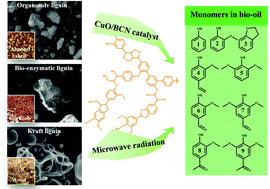当前位置:
X-MOL 学术
›
Green Chem.
›
论文详情
Our official English website, www.x-mol.net, welcomes your feedback! (Note: you will need to create a separate account there.)
Microwave-assisted depolymerization of various types of waste lignins over two-dimensional CuO/BCN catalysts
Green Chemistry ( IF 9.8 ) Pub Date : 2019/12/17 , DOI: 10.1039/c9gc03553b Yang Cao, Season S. Chen, Daniel C. W. Tsang, James H. Clark, Vitaliy L. Budarin, Changwei Hu, Kevin C.-W. Wu, Shicheng Zhang
Green Chemistry ( IF 9.8 ) Pub Date : 2019/12/17 , DOI: 10.1039/c9gc03553b Yang Cao, Season S. Chen, Daniel C. W. Tsang, James H. Clark, Vitaliy L. Budarin, Changwei Hu, Kevin C.-W. Wu, Shicheng Zhang

|
Valorization of lignin to valuable chemicals and biofuels increases the economic viability of sustainable biorefineries. This work aimed at elucidating how the lignin structures recovered from various agricultural and industrial residues governed the downstream catalytic conversion. Three types of lignins, namely bio-enzymatic lignin (BL), organosolv lignin (OL), and Kraft lignin (KL), were fully characterized by HSQC-NMR, TGA, FTIR, and SEM to obtain a detailed description of their structures. In consideration of redox-active CuO and highly active carbon-modified boron nitride (BCN) in oxidative dehydrogenation, a two-dimensional CuO/BCN catalyst was prepared and explored in microwave-assisted lignin conversion to improve the yields of aromatic monomers. BL achieved the highest yield of monomers (10 wt% ) over the CuO/BCN catalyst after the 3rd cycle in 30 min under mild conditions (200 °C). The yields of bio-oils reached 70 wt% in 10 min when BL and OL were used as the substrate. High efficiency of the microwave-assisted reaction was illustrated by comparing with that of the hydrothermal reaction. This work demonstrated strong dependence of the conversion efficiency on the interunit linkages and functional groups of lignin structures. The strong metal–support interaction between CuO and BCN not only facilitated lignin depolymerization via the promoted electron transfer, but also enhanced the stability of Cu catalysts under hydrothermal conditions. In addition, elucidation of the catalyst redox evolution shed light on the role of the CuO/BCN catalyst in lignin depolymerization in recycle runs.
中文翻译:

二维CuO / BCN催化剂对微波处理的各种废木质素的微波辅助解聚
将木质素平衡为有价值的化学物质和生物燃料可提高可持续生物精炼厂的经济可行性。这项工作旨在阐明从各种农业和工业残余物中回收的木质素结构如何控制下游的催化转化。三种类型的木质素,即生物酶木质素(BL),有机溶剂木质素(OL)和牛皮纸木质素(KL),通过HSQC-NMR,TGA,FTIR和SEM进行了全面表征,以获得其结构的详细描述。考虑到氧化脱氢中的氧化还原活性CuO和高活性碳改性的氮化硼(BCN),制备了二维CuO / BCN催化剂,并进行了微波辅助木质素转化研究,以提高芳香族单体的收率。3次后,与CuO / BCN催化剂相比,BL的单体收率最高(10 wt%)次循环在温和条件下(200℃)下30分钟。当BL和OL用作底物时,生物油的产率在10分钟内达到70 wt%。通过与水热反应的比较,说明了微波辅助反应的高效率。这项工作表明转化效率强烈依赖于木质素结构的单元间连接和官能团。CuO和BCN之间强大的金属-载体相互作用不仅通过促进电子转移促进木质素解聚,而且还增强了Cu催化剂在水热条件下的稳定性。另外,对催化剂氧化还原放出的阐明揭示了CuO / BCN催化剂在循环运行中木质素解聚中的作用。
更新日期:2020-02-13
中文翻译:

二维CuO / BCN催化剂对微波处理的各种废木质素的微波辅助解聚
将木质素平衡为有价值的化学物质和生物燃料可提高可持续生物精炼厂的经济可行性。这项工作旨在阐明从各种农业和工业残余物中回收的木质素结构如何控制下游的催化转化。三种类型的木质素,即生物酶木质素(BL),有机溶剂木质素(OL)和牛皮纸木质素(KL),通过HSQC-NMR,TGA,FTIR和SEM进行了全面表征,以获得其结构的详细描述。考虑到氧化脱氢中的氧化还原活性CuO和高活性碳改性的氮化硼(BCN),制备了二维CuO / BCN催化剂,并进行了微波辅助木质素转化研究,以提高芳香族单体的收率。3次后,与CuO / BCN催化剂相比,BL的单体收率最高(10 wt%)次循环在温和条件下(200℃)下30分钟。当BL和OL用作底物时,生物油的产率在10分钟内达到70 wt%。通过与水热反应的比较,说明了微波辅助反应的高效率。这项工作表明转化效率强烈依赖于木质素结构的单元间连接和官能团。CuO和BCN之间强大的金属-载体相互作用不仅通过促进电子转移促进木质素解聚,而且还增强了Cu催化剂在水热条件下的稳定性。另外,对催化剂氧化还原放出的阐明揭示了CuO / BCN催化剂在循环运行中木质素解聚中的作用。


























 京公网安备 11010802027423号
京公网安备 11010802027423号